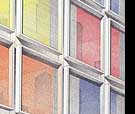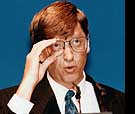1945 The launderette
The House of the future.
Later this year an "Internet refrigerator" will be available in Japan for about £500. As the fridge is always on, Internet access is instantly available along with cold drinks. Japanís V Sync Technology alongside Nihon Silicon Graphics, Cray KK and Sharp have completed a prototype. A desktop PC mounted on the top of a refrigerator connects with the Internet through local cable TV networks. An LCD is embedded on the door of the refrigerator, and you communicate with the computer by a touch panel or voice-recognition software.
While initially this appears to be one of those utterly useless inventions the Japanese specialise in it is an early prototype for the kitchen of the future. Once the fridge computer is programmed it will automatically scan the bar codes on products in the fridge. If they are not returned after a while the machine will assume they have been used up. So when the jar of Hellmanís Mayonnaise is finished it will note this fact and automatically add it to your virtual shopping list. Kitchen cupboards could also be equipped with their own microprocessor and scanners for dry goods. The virtual shopping list can then be checked by the homeowner and emailed to a nearby supermarket.
Similarly London high tech company Knowledge Lab has invented a dustbin that uses bar code reading technology. Whenever you throw away an empty carton of a household product you use regularly the bin will email a local supermarket ordering a replacement. If you throw away a full carton it will register you donít like it.
 St Martinís Lane hotel. |
Working on the principle of a morning tea maker and provided a house is wired up properly a computer can control many simple on/off functions like opening or closing curtains, to running baths and warming the breakfast croissant while simultaneously making the cappuccino. The problem has always been getting it to work more efficiently than Professor Branestawmís fried egg dispenser. That takes time and money.
 Bill Gates |
The house consists of seven main pavilions connected by underground passageways set in five acres of land. It is terraced into a hill that drops 170ft from the top to the waterfront and has video walls throughout. Much of the house is underground, but skylights and windows admit as much natural light as is available. Everything in it appears to be operated silently by magic.
Like the hang out for a James Bond villain the nerve centre is five large mechanical rooms and a central computer room with access restricted on the lower and upper ground floor all powered by its own generators. The central computer - likened by Gates to Hal in Stanley Kubrickís film 2001: A Space Odyssey - controls everything from the heating and air conditioning to the temperature in the boulder-rimmed hot tub, the video-art walls and the climate controls to Billís trampoline in a room with vaulted ceilings and walls that give way to huge high-resolution television screens that appear to be part of the walls. Works of art on the wall and ceiling video screens can be changed to suit the occupant's mood; at the press of a switch, the bathroom walls can become Van Goghs, Salvador Dalis or any one of 100,000 masterpieces to which Bill owns the electronic rights.
Each visitor is given their own PIN (personal identification numbers) that allows the computers to track their movements, open doors, turn lights on and off as they move from room to room. Guests may also select music from a computer console and have the sound follow them wherever they go in the house. What happens when one guest who loves Mozart meets another who prefers the Manic Street Preachers doubtless depends on the grading of the PIN. A solid wall separates the guest rooms from their host's. Contact can be made only via an elevator that whisks the visitor to the entrance hall, formal dining room or arcade below.
In a business where todayís technology quickly becomes last yearís the designers planned the house in such a way that it will not become dated. The interior, according to one of the architects will constantly change while the stone and timber exterior aged with the elements.
In Billís mansion mending a fuse may be a more complicated task and doubtless when the plumber comes it is with a doctorate in physics. But just in case there are any of those unexplained computer glitches, all the rooms have light switches and door handles that can be turned on and opened in the old-fashioned way.

